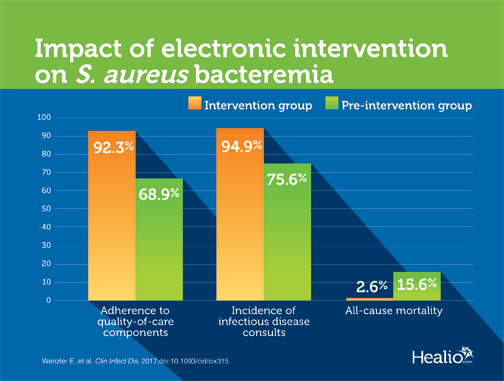Automated intervention improves care for S. aureus bacteremia
An automated intervention increased the number of infectious disease consultations and improved targeted antimicrobial therapy and adherence to quality-of-care measures among patients with Staphylococcus aureus bacteremia, according to findings recently published in Clinical Infectious Diseases.
“Bacteremia is the most well recognized and clinically important manifestation of infection due to Staphylococcus aureus,” Eric Wenzler, PharmD, of the College of Pharmacy at the University of Illinois at Chicago, and colleagues wrote. “Despite this recognition and increased clinical cognizance, the overall mortality rate associated with S. aureus bacteremia has not decreased over the last few decades. Technological advances including electronic medical records and clinical decision support systems allow antimicrobial stewardship programs to deliver higher-quality, more efficient patient care.”
The researchers performed a retrospective, single-center, quasi-experimental study of 84 patients who were hospitalized with S. aureus bacteremia: 39 in an intervention group and 45 in a pre-intervention group. In the intervention period, a scoring tool integrated into electronic medical records alerted pharmacists of patients with S. aureus bacteremia using real-time notifications of positive cultures. The pharmacists then used the scoring tool, along with practice guidelines, to make recommendations promoting adherence to quality-of-care measures and to encourage scheduling infectious disease consultations.
Overall, patients in the intervention group showed significantly better adherence for quality-of-care components (68.9% vs. 92.3%), the researchers reported. The intervention group also showed significant increases in infectious disease consults (75.6% vs. 94.9%). Wenzler and colleagues found no significant differences in length of stay, infection-related length of stay, readmission or bacteremia. However, the pre-intervention group had a 6-fold higher all-cause mortality than the intervention group (15.6% vs. 2.6%; P = .063).
“This is the first study to demonstrate the impact of an automated, pharmacist-driven intervention for the management of patients with S. aureus bacteremia,” Wenzler and colleagues wrote. “We were able to demonstrate a significant improvement in patients receiving an infectious disease consult, targeted antimicrobial therapy and adherence to all S. aureus bacteremia quality-of-care measures. As antimicrobial stewardship becomes a mandatory aspect of health care in all hospitals in the U.S., antimicrobial stewardship programs will be forced to find ways to provide more efficient, impactful, disease state-based patient care. Our study provides the framework for and data to support this intervention in one of the most clinically important infectious diseases syndromes, S. aureus bacteremia.” – by Andy Polhamus
Disclosure: The researchers report no relevant financial disclosures.

